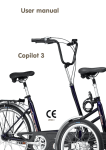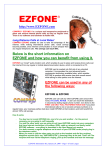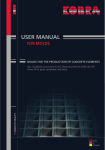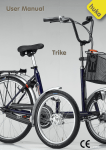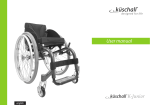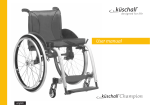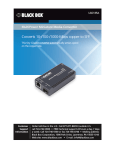Download Table of contents Information for Therapists and DME
Transcript
Information for Therapists and DME Dealers Programming and Service Guide · Model E25/E26 Status 03/ 2006 1 Table of contents Performance settings 2 Driving programs 2 Adjustable parameters 3 Select parameter set self-driver/intuitive attendant controller 3 Forward speed 3 Reverse speed 3 Acceleration 3 Braking 4 Turning speed 4 Sensitivity 4 Acoustic signals 4 Parking brake 4 Auto shut-off 4 Joystick throw 5 Battery size 5 Axis change 5 Display options 5 Speed reduction 5 Activating the programming mode 6 Selection of parameter set self-driver/intuitive attendant controller 7 Parameter adjust 7 Restore factory setup 8 Parameter table 9 Diagnostic codes/failure detection 10 Performance settings The e-fix performance can be adapted to many different customers needs and therapeutic requirements. To adjust the performance, no extra or external programming device is needed. All parameters can be adjusted via joystick and 2 the build-in LCD display by using a small programming key to activate the programming mode. Programming key Attention! All performance setting should only be executed by professional personnel like Therapists or Certified Medical Equipment Dealers. For safety reasons, the programming key should not be handed over to the end user. To avoid any incident, make sure that the user is in the position to deal with the new performance set-up after re-programming has been executed. Please pay attention to warnings as described in the operator's manual. Driving programs The e-fix E25/E26 has two programs available – the mode for self-driving and the mode for the settings of the intuitive attendant control. The intuitive attendant control is available as an optional accessory. Both modes can be programmed largely independently of one another, so that different parameters can be used during operation by the wheelchair driver as opposed to when an attendant is using the intuitive attendant control. Adjustable parameters The following parameters can be adjusted to the users needs: Select parameter set self-driver/intuitive attendant controller · With the E25/E26 the parameter sets can be programmed independently of one another for operation as a self-driver and with the intuitive attendant controller, for example, being set slower and with finer control for use as a self-driver indoors, and for outdoors in combination with the intuitive attendant control and set to maximum speed and precise forward running. For example, these settings could be used for a child. · The following parameters are changed when programming both operating modes (selfdriver and intuitive attendant controller) together and cannot be set separately for the relevant purpose: 7 Acoustic signals 8 Parking brake 9 Auto shut-off are the same for both operating modes 11 Battery capacity 13 Display options · Can be adjusted depending on the capacity of the driver. Forward speed · Sets the maximum forward speed. · Reduction of speed is recommended for beginners or for use exclusively indoors. · Reduction also sensible for older users. Reverse speed · Sets the maximum reverse speed, independent of turning and forward speed. · For safety reasons maximum at 70 % of adjusted forward speed. · Factory pre-set at 50 % of forward speed. · Generally reduced for very slow driving (e.g. users with less coordination or upper body tonus, geriatric users). Acceleration · Set time taken to reach maximum forward speed. · Also perceived by the user as "Reaction" (prompt/sluggish). · Reduced to accommodate tremors or ataxia (generally when there is a low weight of wheelchair plus patient). · Increase to enable small obstructions to be overcome more easily at low speeds (e.g. thresholds indoors). 3 Braking · The time taken for braking from the maximum speed to the desired speed or to standstill. · Reduction if very gentle driving is required at lower speeds (e.g. for users with 4 diminished upper body/trunk stability.) · Increase if very precise driving is required at lower speeds (e.g. confined living room) or rapid reaction is desired. Turning speed · Set the maximum turning speed for driving a circle/curve and is independent of forward speed settings. · High turning speeds are generally not recommended for safety e.g. with control by escorting person. · Reduced for good tracking at fast speeds. · Increased for slow speeds (Indoor use) for tight cornering. Sensitivity · Sets time to reach maximum turning speed. · Typically referred to as Response by the driver. · To be reduced to accommodate Tremor, Ataxia (Tremor dampening) or with control by escorting person. Acoustic signals · Activates / Disables acoustic signals like low battery signal. Parking brake · Time for electromagnetic brake to engage after a Joystick signal has been applied. · Factory pre-set at “Delayed” to reduce noise - motors stops by electric governor brake. · Change to “Immediate” if immediate stop is required e.g. to ride close up to edges like curbstones. Auto shut-off · Determines time until unit switches off automatically to save energy. · Can be set from between 5 minutes to 3 hours (factory pre–set at 1 hour). Joystick throw · Attaining the maximum speed dependent on joystick displacement. . Setting to 1 bar (minimum) means that: after 50 % of the way (half displacement of the joystick) the maximum speed will already be reached. A further displacement beyond that does not increase the speed. · Makes sense for those with little muscular strength (MD), with restricted arm and/or hand function or when used as mouth or chin controller. Battery size · To provide most exact battery indication, the battery size can be adjusted for 2 different types of the battery pack. · Factory pre-set according to battery size ordered. Axis change · Different settings to change the four directions of movement. · For those with little muscle power (muscular dystrophy) or with limited arm or hand functions. Joystick displacement Obstruction: e.g. table edge Attention! With changed movement parameter 12 “Axis change” the e-fix may only be operated with the protection bar for control unit (order no. 1456941) to protect the hand and the joystick! During assembly please make sure that protection bar handle is higher than the joystick or at least equally high! On bumping into an obstacle, (e.g. a tabletop), the joystick will be displaced even more. Consequently the patient will not be able to get out of this situation single-handedly. He will be effectively pinned in. If such a situation should arise, all that the patient can do is to switch off the e-fix. Direction of movement Display options Additional display of milage or speed is possible. Speed reduction · Decreases the maximum speed for function chairs (lift chair, stand-up chair, …) with activated Speed Stop/Limit switch. 5 Activating the programming mode To enter the programming mode, the following steps are necessary: Switch the unit off by pressing the power switch [2]. Put the programming key [1] into the key hole as shown in the drawing and leave the key in the key hole. 6 Switch the unit on by pressing the power switch [2]. Now, the display [3] will 1 indicate that the programming mode is activated by showing the symbol , and Code “0” and one bar. To change parameter / performance settings, proceed as described in the following paragraphs. 2 3 Selection of parameter set self-drive mode and mode for intuitive attendant control Now choose the parameter set you like to modify. Initially the mode in which you currently are will be shown: – One bar = – Two bars = Self-drive mode Mode for intuitive attendant controller Self-drive mode To switch between self-drive mode and mode for intuitive attendant control, move Joystick forward or backward as described in the later paragraph “Parameter Adjust” Parameter adjust After you have chosen which parameter set you like to adjust, you may begin Mode for intuitive to select and change the performance of individual parameters. By moving the attendant controller. joystick to the right or left you switch up and down between the different parameters. [Fig. 1] · Joystick to the right: Parameter Code (1 – 14) steps up (next higher parameter) [Fig. 2] · Joystick to the left: Parameter Code (1 – 14) steps down (next lower parameter) [Fig. 3] · Joystick forward: Value of parameter will be increased (faster) or functions are switched ON (e.g. acoustic signal) [Fig. 4] · Joystick backward: Value of parameter will be decreased (slower) of functions are switched OFF. 7 For parameter intensity refer to Parameter Table on page 8. End of programming: – Remove programming key [1] from the bottom of the Joystick – The new setup is now automatically stored – Test drive wheelchair with new setup 8 Restore factory setup The original factory setup can be restored at every time as follows: · Switch the e-fix off. · Put the programming key [1] into the key hole as shown in the drawing and leave the key in the key hole. 1 · Pull Joystick [4] backward an hold in maximum backward position. · Switch the unit ON by pressing the power switch [2]. · Wait for 2 seconds to allow the software to reset. The Display [3] indicates know as shown in [Fig. 5]. · Remove programming key [1] from keyhole. 2 3 4 E20 display after reset [Fig. 5] · Unit can now be operated with original factory setup. Parameter Table (Factory pre-sets are bold and underlined) DESCRIPTION DRIVING MODE PARAMETER 0 BARS 1 Bar 2 Bars DRIVING MODE Self-Drive Intuitive attendant control DESCRIPTION FORWARD SPEED PARAMETER 1 BARS 1 Bar 2 Bars 3 Bars 4 Bars 5 Bars SELF-DRIVE 1,2 km/h 2,4 km/h 3,6 km/h 4,8 km/h 6,0 km/h INTUITIVE ATTENDANT CONTROL 3,5 km/h 4,0 km/h 4,5 km/h 5,0 km/h 5,5 km/h 30 % of Forward 40 % of Forward 50 % of Forward 60 % of Forward 70 % of Forward 9 REVERSE SPEED 2 1 2 3 4 5 Bar Bars Bars Bars Bars 30 % 40 % 50 % 60 % 70 % ACCELERATION 3 1 2 3 4 5 Bar Bars Bars Bars Bars 3,5 seconds 3,0 seconds 2,5 seconds 2,0 seconds 1,5 seconds 4,4 seconds 3,8 seconds 3,1 seconds 2,5 seconds 1,9 seconds BRAKING 4 1 2 3 4 5 Bar Bars Bars Bars Bars 3,5 seconds 3,0 seconds 2,5 seconds 2,0 seconds 1,5 seconds 4,4 seconds 3,8 seconds 3,1 seconds 2,5 seconds 1,9 seconds TURNING SPEED 5 1 2 3 4 5 Bar Bars Bars Bars Bars 13 % 27 % 30 % 33 % 36 % 11 % of Forward 23 % of Forward 26 % of Forward 28 % of Forward 31 % of Forward SENSITIVITY 6 1 2 3 4 5 Bar Bars Bars Bars Bars 2,21 seconds 0,13 seconds 0,08 seconds 0,05 seconds 0,04 seconds 0,25 seconds 0,15 seconds 0,10 seconds 0,06 seconds 0,05 seconds ACOUSTIC SIGNAL 7 1 Bar 5 Bars Deactivated Activated Deactivated Activated BRAKE 8 1 Bar 5 Bars Delayed Immediate Delayed Immediate AUTO SHUT-OFF 9 1 2 3 4 5 5 minutes 10 minutes 15 minutes 1 hour 3 hours 5 minutes 10 minutes 15 minutes 1 hour 3 hours Bar Bars Bars Bars Bars of Forward Speed of Forward Speed of Forward Speed of Forward Speed of Forward Speed of Forward Speed of Forward Speed of Forward Speed of Forward Speed of Forward Speed Speed Speed Speed Speed Speed Speed Speed Speed Speed Speed JOYSTICK THROW 10 1 Bar 5 Bars 50 % 100 % 50 % 100 % BATTERY SIZE 11 1 2 3 4 5 12 Ah Multipower 15 Ah PBQ 22 Ah Multipower 22 Ah PBQ 34 Ah Panasonic (2 x 17 Ah) Special Edition 12 Ah Multipower 15 Ah PBQ 22 Ah Multipower 22 Ah PBQ 34 Ah Panasonic (2 x 17 Ah) Special Edition Bar Bars Bars Bars Bars 10 DESCRIPTION AXIS CHANGE PARAMETER 12 BARS 1 Bar 2 Bars 3 Bars 4 Bars SELF-DRIVE no change Swap axes: forwards/backwards Swap axes: left/right Swap axes: forwards/backwards and left/right INTUITIVE ATTENDANT CONTROLLER no change Swap axes: forwards/backwards Swap axes: left/right Swap axes: forwards/backwards and left/right DISPLAY OPTIONS 13 1 2 3 4 5 normal display Speed kph Milage count km Speed mph Milage count miles normal display Speed kph Milage count km Speed mph Milage count miles SPEED REDUCTION (ONLY WITH ACCESSORY) 14 1 Bar 2 Bars 3 Bars 4 Bars 5 Bars 0 % of parameters 1 and 2 30 % of parameters 1 and 2 40 % of parameters 1 and 2 50 % of parameters 1 and 2 60 % of parameters 1 and 2 0 % of parameters 1 and 2 30 % of parameters 1 and 2 40 % of parameters 1 and 2 50 % of parameters 1 and 2 60 % of parameters 1 and 2 Bar Bars Bars Bars Bars Diagnostic codes / failure detection The e-fix software is equipped with an automatic failure detection system. Numbercode Symbol Display e-fix [Fig. 6] If a failure occurs, the LCD display will indicate the current fault by a number code and a symbol as shown in [Fig. 6], otherwise an intermittent sound is heard. Many faults are caused because of bad or poorly charged batteries (code 21). As the e-fix drive wheels can be disengaged for manual operation, failure codes L and R (left or right wheel disengaged) are also frequent. This can be corrected by re-engaging the drive wheel to “power” (refer to user manual). DISPLAY DESCRIPTION CAUSE REMEDY none Battery capacity display flashes; Wheelchair runs more slowly The motors act as generators when travelling downhill and put power back into the batteries. This reaction stops as soon the battery pack is no longer fully charged. 1 Exclamation mark symbol flashes; Battery capacity display active Microcontroller in controller is defective. Replace the PCB or send in the controller for repair. 3 ,L5, R5 Wheel symbol flashes; Exclamation mark symbol lights up Different wheels (diameter or rating) installed on left and right sides. Install two drive wheels of the same type. L4 R4 Wheel symbol flashes; Exclamation mark symbol lights up; Letter “L” or “R” flashes No communication with drive wheel “left”. No communication with drive wheel “right”. Swap over the wheels left and right. If the error still occurs, repair or swap the wheel, otherwise repair or swap the wiring. E4 Exclamation mark symbol lights up; Letter “E” flashes No communication with the special controller. Check the connections of the special controller or whether a special controller has been connected at all. Otherwise, restore the factory settings. S4 Exclamation mark symbol lights up; Letter “E” flashes No communication with the special controller. Check the wiring of the special controller. none Lock symbol flashes; Exclamation mark symbol lights up Anti-theft lock is active. Press the menu button for approx. 3 seconds. DISPLAY DESCRIPTION CAUSE REMEDY 7 - 10, 14, 15, 20 Battery capacity display active Microcontroller in controller is defective. Replace the PCB or send in the controller for repair. 11 Exclamation mark symbol lights up Battery voltage not in permissible range. Replace the battery cells or send in the battery pack for repair. 12 Exclamation mark symbol lights up Incorrect connection of the Speed Stop/ Limit switch. Check the connection and the wiring of the Speed Stop/Limit switch. Otherwise, restore the factory settings. 13 Exclamation mark symbol lights up Cable breakage or short circuit in the battery pack. Replace the wiring in the battery pack or send in the battery pack for repair. 16 - 18 Exclamation mark symbol lights up Joystick in controller is defective. Replace the joystick or send in the controller for repair. 19 Exclamation mark symbol lights up Special controller Check the joystick of the special controller. 21 Exclamation mark symbol lights up Voltage in the battery pack is less than 19.2 V. Battery shows undervoltage or deep discharge. Replace the battery cells or send in the battery pack for repair. L1 R1 Exclamation mark symbol lights up Cutoff due to overload in drive unit “left” Let the wheels cool down and check whether the Temperature symbol lights up Cutoff due to overload in drive unit “right” wheelchair occupant had driven with the brakes Wheel symbol flashes on. Otherwise replace the PCB or send in the wheel Letter “L” or “R” flashes for repair. L2 R2 Exclamation mark symbol lights up Battery pack voltage too low at left or Wheel symbol flashes right drive wheel. Letter “L” or “R” flashes Let the wheels cool down and check whether the wheelchair occupant had driven with the brakes on. Otherwise replace the PCB or send in the wheel for repair. L3 R3 Exclamation mark symbol lights up Battery pack voltage too low at left or Temperature symbol lights up right drive wheel. Wheel symbol flashes Letter “L” or “R” flashes Let the wheels cool down and check whether the wheelchair occupant had driven with the brakes on. Otherwise replace the PCB or send in the wheel for repair. L R Exclamation mark symbol lights up Temperature symbol flashes Letter “L” or “R” flashes Battery capacity display active Let the wheels cool down and check whether the wheelchair occupant had driven with the brakes on. Otherwise replace the PCB or send in the wheel for repair. L R Exclamation mark symbol lights up Manual operation unit “left” Wheel symbol flashes Manual operation unit “right” Letter “L” or “R” lights up Couple in the drive wheels. L5 R5 Exclamation mark symbol lights up Different wheels (diameter or rating) Wheel symbol flashes installed on left and right sides. Letter “L” or “R” lights up Install two drive wheels of the same type. L6 R6 Exclamation mark symbol lights up Microcontroller in drive wheel is defective. Replace the PCB or send in the wheel for repair. Wheel symbol flashes Letter “L” or “R” lights up Operating temperature warning unit for drive unit, “left”. Operating temperature warning unit for drive unit, “right”. 11 12 DISPLAY DESCRIPTION CAUSE L7 - L17 R7 - R17 Exclamation mark symbol lights up Microcontroller in drive wheel is defective. Replace the PCB or send in the wheel for repair. Wheel symbol flashes Letter “L” or “R” flashes L18 - L20 Exclamation mark symbol lights up Cabling of the interface is defective. R18 - R20 Wheel symbol flashes Letter “L” or “R” flashes REMEDY Replace the defective cable or send in the interface for repair. L21 R21 Exclamation mark symbol lights up Microcontroller in drive wheel is defective. Check the connections of the special controller. Wheel symbol flashes Letter “L” or “R” flashes E0 - E7 Exclamation mark symbol flashes Letter “E” flashes Special controller is defective. Check the connections of the special controller. S0 - S3 S5 - S9 Exclamation mark symbol flashes Letter “S” flashes Special controller is defective. Check the connections of the special controller.












